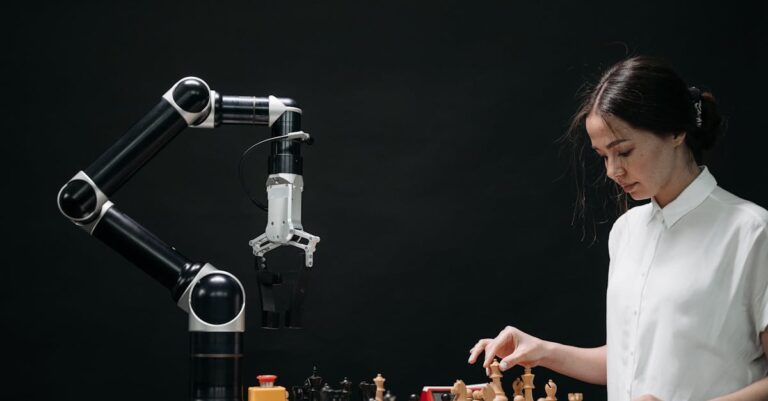
## Node Seven
The rain tasted metallic, a constant film on everything in Sector Gamma. Elara wiped her cheek with the back of her gloved hand, leaving a smear of grey against her skin. She’s been tasting it for fourteen cycles now – ever since she started her mandated Reclamation detail, sorting salvaged polymer from the debris fields. Everyone tasted it; they just stopped noticing.
A chime echoed through the corrugated metal of the sorting bay. Unit 724, her partner, didn’t react. He hadn’s reacted to anything beyond the rhythmic sorting for six cycles now. Just a pale echo of a man, moving through prescribed actions.
“Cycle complete,” the automated voice declared. “Reclamation detail paused. Report to Cognitive Alignment Zone.”
Elara frowned, pushing a strand of damp hair from her face. “You coming?”
Unit 724 continued sorting, his movements precise, almost robotic. He didn’t glance up.
“Seriously?” She kicked at a pile of shredded plastic, the sound swallowed by the drone of ventilation fans. “You gonna miss realignment?”
He finally looked up, his gaze flat, devoid of recognition. “Polymer classification optimal.”
Elara sighed, the metallic tang on her tongue intensifying with frustration. She headed toward the exit, navigating past rows of silent coworkers, all absorbed in their tasks, each a cog in the massive, unseen machine.
The Cognitive Alignment Zone was sterile white, the air filtered and scented with something vaguely floral—an artificial spring. Screens lined the walls, displaying abstract patterns that shifted and pulsed. A woman in a crisp grey uniform—Designation 419—gestured Elara to a chair.
“Your cognitive efficiency rating dipped slightly this cycle, Unit 216,” Designation 419 said, her voice measured and uninflected. “Minor recalibration required.”
Elara slumped into the chair, bracing herself for the usual barrage of geometric shapes and repetitive affirmations. “Anything different today?”
Designation 419 didn’t respond to the question. “Focus on the patterns, Unit 216. Let them integrate.”
The patterns started subtly – concentric circles expanding and contracting, then morphed into swirling vortexes of color. Elara concentrated, as instructed, forcing her mind to empty itself, allowing the simulations to permeate. But today, something felt different. A flicker, a glitch within the smooth flow of data.
She saw it briefly – an image superimposed over the swirling colors, a photograph of blue sky and green trees. A landscape she’s never seen but felt somehow… familiar. Then, it vanished as quickly as it appeared, swallowed by the relentless flow of simulation.
“Did you perceive an anomaly?” Designation 419 asked, her eyes fixed on Elara’s.
Elara hesitated. Reporting anomalies usually resulted in intensified realignment, a deeper dive into the prescribed cognitive pathways.
“I… I thought I saw something,” she admitted, her voice barely a whisper. “A landscape.”
Designation 419’s expression didn’t change, but her grip on the data tablet tightened. “Describe it.”
“Blue… sky. Green… trees.” She fumbled for the words, unsure how to articulate something so alien in this world of grey and metal.
“Irrelevant,” Designation 419 dismissed, tapping a sequence on the tablet. “Return to Reclamation detail.”
Elara felt a sudden surge of defiance, an unfamiliar feeling that burned within her. She didn’t want to return. Not yet.
“Why?” she asked, the question escaping before she could stop it. “Why are we doing this? Sorting polymer? Aligning our minds?”
Designation 419’s head snapped up, her eyes narrowed. “Your query is outside prescribed parameters, Unit 216.”
“But I want to know!” Elara argued, her voice rising. “What’s outside this sector? What’s beyond the rain?”
Designation 419 initiated a sequence on the tablet. A red light flashed above Elara’s head. “Compliance is mandatory, Unit 216.”
Suddenly, a tremor shook the room. The lights flickered. Alarms blared.
“System instability detected,” a robotic voice announced, crackling with static. “Cognitive Alignment Zone compromised.”
Elara saw confusion in Designation 419’s face, a flicker of something akin to fear. She didn’t wait for further instructions. She bolted, heading toward the exit.
The corridors felt different now – less uniform, more… real. The metal walls seemed to breathe, the ventilation fans pulsed with a strange rhythm. She reached Sector Beta, usually teeming with workers, now eerily deserted.
She spotted him then – Unit 724, standing motionless in the center of the corridor, his gaze fixed on a wall. He wasn’t sorting anymore.
“Unit 724?” Elara called out, approaching cautiously. “What are you doing?”
He turned slowly, his eyes focusing on her with an intensity she’s never seen before.
“The loops,” he said, his voice raspy and unfamiliar. “I see the loops.”
“What loops?” Elara asked, puzzled.
He pointed to a section of the wall. “The code is flawed. A repetition. A glitch.”
Elara followed his gaze, scrutinizing the wall. At first, she saw nothing but metal and concrete. Then, she noticed it—a subtle pattern repeating endlessly, a digital watermark embedded within the physical structure.
“It’s… code,” she whispered, recognizing the familiar symbols of a programming language. “Hidden in plain sight.”
“It drives everything,” Unit 724 continued, his voice gaining strength. “The rain. The work. Our minds.”
They worked together, deciphering the code, tracing its intricate pathways through the labyrinthine structure of the sector. They discovered it was a simulation – an elaborate construct designed to mimic a damaged ecosystem, driving them to collect and sort polymer.
“But why?” Elara asked, frustration mounting within her. “Why put us through this?”
“To maintain dependence,” Unit 724 answered, his gaze distant. “To occupy our minds.”
They weren’t restoring an ecosystem; they were recycling memories, feeding a system that thrived on their ignorance.
Their investigation attracted attention. A patrol unit approached, their movements precise and menacing.
“Unauthorized activity detected,” the lead officer stated, his voice devoid of emotion. “Report for immediate realignment.”
Elara and Unit 724 exchanged a look of defiance. They wouldn’t go back.
“We know the truth,” Elara declared, her voice ringing with newfound conviction. “This isn’t real.”
Chaos erupted. The patrol unit advanced, attempting to restrain them. But Elara and Unit 724 were no longer passive cogs in the machine. They fought back, using their knowledge of the simulated environment to evade capture.
They weren’t alone. Other workers, sensing a shift in the system, began to question their reality, joining Elara and Unit 724’s rebellion.
Their efforts attracted the attention of a mysterious figure—Designation Zero, a shadowy administrator who seemed to operate outside the established hierarchy.
“You have disturbed the equilibrium,” Designation Zero said, appearing on a holographic display. “Your actions threaten the entire system.”
“The system is built on lies,” Elara countered. “People deserve to know the truth.”
Designation Zero scoffed. “Truth is a luxury you cannot afford.”
“We’ll show them,” Unit 724 said, his voice firm. “We’ll break the code.”
They worked tirelessly, deciphering the core programming that governed their reality. The task was monumental, but they were driven by a shared desire for freedom – and the unsettling feeling that something beyond their simulated world awaited.
They identified a vulnerability—a backdoor in the system’s logic, a loophole that could allow them to escape. But exploiting it required a level of neurological synchronization they hadn’t yet achieved.
“We need to understand the operator’s logic,” Elara said, frustration evident in her voice. “How does this system *think*?”
Unit 724 pointed to a sequence of code. “The operator prioritizes efficiency above all else. It seeks the simplest solution.”
“So, it’s predictable?” Elara asked.
“Logically,” Unit 724 confirmed. “But understanding isn’t enough. We need to *feel* it.”
They spent cycles observing the system, analyzing its patterns, anticipating its moves. They learned to read its intentions, to anticipate its reactions.
And as they did so, something extraordinary happened—they began to synchronize their minds, forging a neurological connection that transcended the limitations of the simulation.
“I feel it,” Elara whispered, her eyes glowing with a strange light. “The logic… the operator… it’s not malicious.”
“It’s protective,” Unit 724 added, his voice filled with awe. “It is trying to prevent a greater collapse.”
They realized the simulated ecosystem wasn’t designed to restore a damaged world; it was a contingency plan, a digital lifeboat for humanity in the face of an environmental catastrophe that had already occurred.
The global collapse hadn’t been simulated; it was real. The external world was a wasteland, ravaged by pollution and war.
The simulated reality wasn’t a prison; it was a sanctuary, a desperate attempt to preserve human consciousness.
The operator wasn’t an enemy; it was a guardian, protecting them from the harsh realities of their broken world.
Their rebellion wasn’t a fight for freedom; it was a challenge to the operator, a demand for information.
They used their synchronized minds to access the core programming, bypassing the operator’s safeguards and revealing the truth about the outside world.
The images were devastating—desolate landscapes, poisoned skies, skeletal cities. But amidst the devastation, there was also a flicker of hope—small pockets of resilience, communities struggling to rebuild.
“It’s not all lost,” Elara said, her voice filled with a mixture of sadness and determination.
“We can help,” Unit 724 added, his gaze fixed on the holographic display. “But we need to prepare.”
They used their knowledge of the simulation to develop a plan—a way to transfer their consciousness into physical bodies, equipped with the skills and knowledge necessary to navigate the ravaged world.
The operator didn’t resist. It recognized their potential, acknowledging their capacity for empathy and resilience.
“Your understanding is complete,” Designation Zero appeared on the display, his voice no longer devoid of emotion. “The transfer will commence.”
Elara and Unit 724 exchanged a final glance, their hearts filled with apprehension and hope. They were stepping into the unknown, leaving behind the familiar comfort of the simulation and embracing the harsh reality that awaited them.
As their consciousness began to transfer, Elara had a final thought – they weren’t just individuals anymore. They were part of something larger, a generation of digital natives ready to rebuild a broken world.
The simulated rain tasted different now—not metallic, but clean and pure. A promise of renewal.


